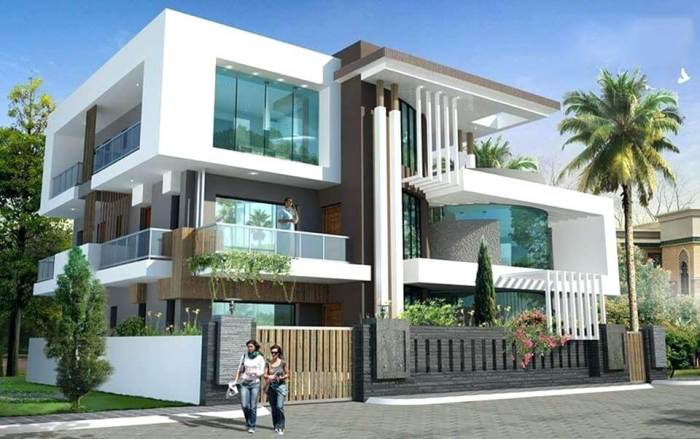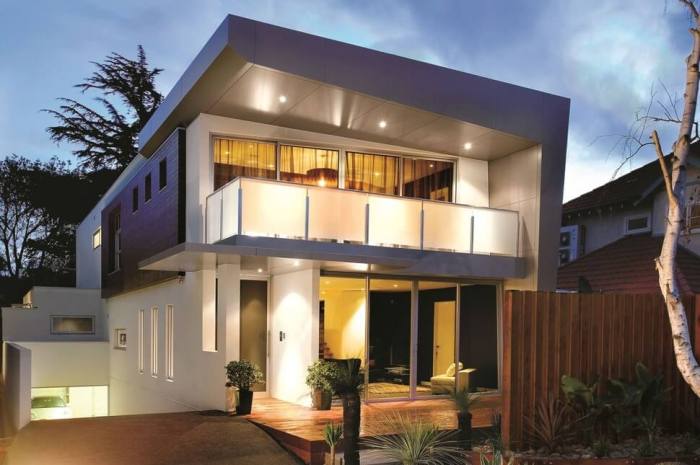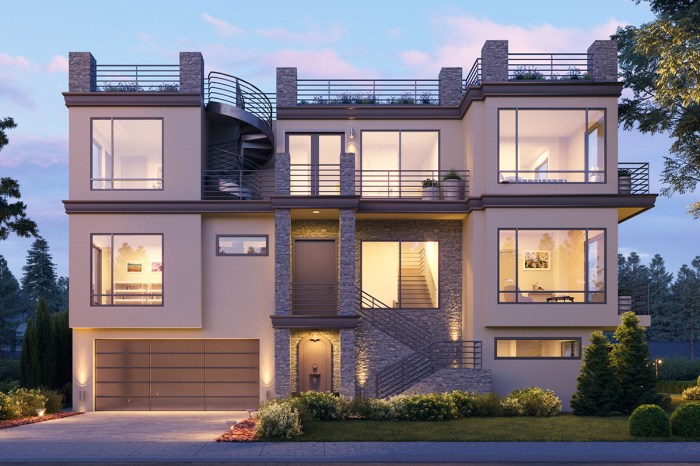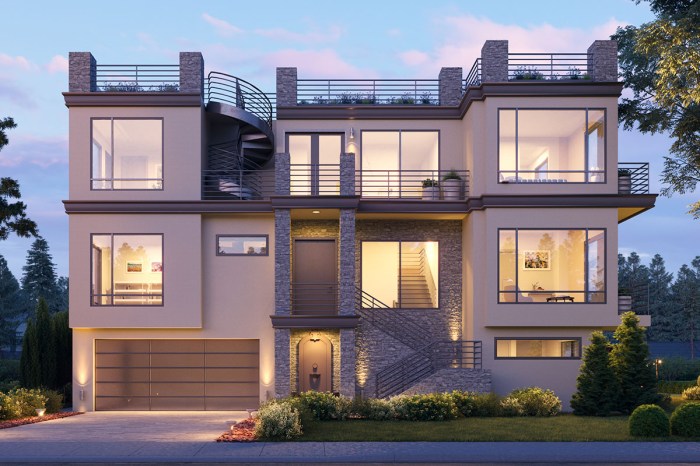3 Story House Interior Design: A Comprehensive Guide
3 Story House Interior Design presents unique challenges and opportunities for creating a cohesive and functional living space. The vertical layout demands careful consideration of space allocation, flow, and natural light, while also offering the potential for stunning architectural features and breathtaking views.
This guide explores the intricacies of designing a 3-story home, from understanding the layout and defining the style to optimizing space, incorporating natural light, and selecting furniture and decorative elements. We’ll delve into practical tips and design solutions to help you create a beautiful and comfortable home that seamlessly connects all three floors.
Incorporating Natural Light and Ventilation
A well-designed three-story home prioritizes natural light and ventilation for a comfortable and healthy living environment. By strategically placing windows and implementing cross-ventilation techniques, you can create a space that is naturally bright and airy throughout the day.
Maximizing Natural Light, 3 story house interior design
Maximizing natural light is crucial for creating a welcoming and vibrant atmosphere. Here are some techniques for achieving this in a three-story home:
- Large Windows:Utilize large windows, especially on the south-facing side, to allow maximum sunlight penetration. Consider floor-to-ceiling windows for a dramatic effect and increased light intake.
- Skylights:Install skylights in hallways, stairwells, and rooms with limited natural light. Skylights provide a direct source of sunlight and can significantly brighten the interior.
- Lightwells:Incorporate lightwells in areas where direct sunlight is limited, such as the center of the house or lower floors. These vertical shafts act as natural light channels, bringing light deep into the interior.
- Reflective Surfaces:Use light-colored walls and reflective surfaces, such as mirrors and polished floors, to bounce light around the house and create a sense of spaciousness.
- Glass Partitions:Consider using glass partitions between rooms to allow light to flow freely between spaces, creating a more open and connected feel.
Designing for Optimal Cross-Ventilation
Cross-ventilation is the process of creating air circulation by opening windows on opposite sides of a room. This allows fresh air to flow through the house, removing stale air and maintaining a comfortable temperature.
- Window Placement:Place windows on opposite walls of each room to facilitate cross-ventilation. Consider strategically positioning windows on different floors to create a natural air flow throughout the house.
- Window Size and Placement:Ensure that windows are large enough to allow for adequate airflow. In areas with strong winds, consider using smaller windows or installing louvers to control airflow.
- Doors and Windows:Consider using French doors or sliding glass doors that open to balconies or patios to create a direct connection between indoor and outdoor spaces, promoting air circulation.
- Ceiling Fans:Install ceiling fans in each room to aid in air circulation, especially during warmer months. Ceiling fans can also help distribute warm air during the winter.
Window Styles and Suitability
| Window Style | Suitability |
|---|---|
| Casement Windows | Ideal for ventilation due to their ability to open wide, offering a large opening for airflow. |
| Double-Hung Windows | Versatile and suitable for various rooms, offering both ventilation and privacy control. |
| Awning Windows | Excellent for ventilation in rainy weather, as they open outward, allowing air to flow in while keeping rain out. |
| Bay Windows | Add character and light to rooms, offering a wide view and increased light intake. |
| Sliding Windows | Suitable for larger openings, offering easy access to balconies or patios. |
Decorative Elements and Accents

Decorative elements and accents are the finishing touches that bring a house interior to life. They add personality, style, and a sense of completeness to the overall design. These elements can range from artwork and lighting to rugs and furniture, each contributing to the unique character of the space.
Artwork
Artwork plays a significant role in defining the aesthetic of a room. It can be used to create focal points, add color, and express personal style.
- Placement:Artwork should be placed strategically to enhance the flow of the room and create visual interest. For instance, a large piece of artwork can be used to draw attention to a specific area, while smaller pieces can be used to fill empty spaces or create a gallery wall.
- Scale and Proportion:The size and scale of artwork should be considered in relation to the size of the room and the furniture. Too large a piece can overwhelm a small space, while too small a piece can get lost in a large space.
- Style and Theme:Artwork should complement the overall design style of the room. For example, abstract art might be suitable for a modern space, while traditional paintings might be more appropriate for a classic setting.
Lighting
Lighting is an essential element in interior design, as it can dramatically impact the mood and atmosphere of a room.
Designing a three-story house offers unique challenges and opportunities. The vertical space allows for creative layouts and a sense of grandeur. However, maximizing natural light and ensuring seamless flow between floors requires careful planning. For those seeking a more manageable design, a 2 floor house interior design can offer a balance of space and practicality.
Ultimately, the ideal choice depends on individual needs and preferences, but both styles can result in stunning and functional homes.
- Ambient Lighting:Ambient lighting provides overall illumination for a space and can be achieved through ceiling fixtures, such as chandeliers or recessed lights. This type of lighting should be soft and even, creating a comfortable and inviting atmosphere.
- Task Lighting:Task lighting is designed to illuminate specific areas where activities are performed, such as reading, cooking, or working. Examples include desk lamps, under-cabinet lighting, and reading lights.
- Accent Lighting:Accent lighting is used to highlight specific features, such as artwork, sculptures, or architectural details. It can be achieved using spotlights, track lighting, or sconces. Accent lighting adds depth and dimension to a space, creating a sense of drama and intrigue.
Rugs
Rugs are a versatile decorative element that can add warmth, texture, and color to a room.
- Size and Shape:Rugs should be chosen based on the size and shape of the room and the furniture. A large rug can anchor a seating area, while a smaller rug can define a specific space within a larger room.
- Material and Texture:The material and texture of a rug can significantly impact the overall feel of a room. Natural fibers, such as wool and cotton, are durable and add warmth, while synthetic fibers can be more affordable and easier to maintain.
- Color and Pattern:The color and pattern of a rug should complement the overall design scheme of the room. A bold pattern can add a focal point, while a subtle pattern can create a sense of tranquility.
Personal Touches
Incorporating personal touches is crucial for creating a unique and inviting atmosphere. This can be achieved through:
- Family Photos:Displaying family photos in thoughtfully curated frames or albums adds a personal touch and creates a warm and welcoming environment.
- Travel Souvenirs:Items collected from travels, such as art pieces, sculptures, or decorative objects, can be used to add character and tell stories about your experiences.
- Hobbies and Interests:Displaying items related to your hobbies or interests, such as musical instruments, books, or sports memorabilia, can reflect your personality and passions.
Kitchen and Dining Room Design

In a three-story home, the kitchen and dining room are essential spaces that foster both functionality and social interaction. The design of these spaces should reflect the homeowner’s lifestyle and preferences while maximizing efficiency and aesthetic appeal.
Kitchen Layout Optimization
A well-designed kitchen layout promotes a smooth workflow and enhances the overall cooking experience. The kitchen should be organized around the “work triangle,” which connects the sink, refrigerator, and stovetop. The ideal distance between these three points should be between 4 and 6 feet, allowing for comfortable movement and easy access.
- Island or Peninsula:A central island or peninsula provides additional counter space, storage, and seating. This can be especially beneficial in larger kitchens, serving as a gathering spot for family and friends.
- Appliance Placement:Consider the placement of appliances based on their frequency of use. For example, the microwave can be located near the refrigerator or above the stovetop for easy access.
- Storage Solutions:Maximize storage space by incorporating cabinets, drawers, and shelves. Utilize vertical space with tall cabinets and consider pull-out drawers for easy access to frequently used items.
Dining Room Design
The dining room is the heart of the home, where family and friends gather to share meals and create lasting memories. Creating a cohesive and inviting dining space requires careful consideration of design elements.
- Dining Table Selection:Choose a table that comfortably accommodates the size of the family and guests. Consider the shape, style, and material of the table to complement the overall design aesthetic.
- Seating Arrangement:Select chairs that are comfortable and complement the table. Consider the placement of chairs around the table, allowing for adequate space and easy movement.
- Lighting:Appropriate lighting is crucial for creating a warm and inviting ambiance in the dining room. A combination of ambient, task, and accent lighting can enhance the dining experience. Ambient lighting provides overall illumination, while task lighting can be used over the table for reading or dining.
Accent lighting can highlight decorative elements, such as artwork or plants.
Color, Materials, and Lighting
Color, materials, and lighting play a crucial role in shaping the ambiance of the kitchen and dining room.
- Color Palette:Neutral colors, such as white, gray, and beige, create a clean and spacious feel. Bold colors, such as red, blue, or green, can add a touch of personality and vibrancy. Consider the natural light available and the desired mood when choosing colors.
- Materials:Natural materials, such as wood, stone, and metal, create a warm and inviting ambiance. Modern materials, such as stainless steel and glass, can add a sleek and contemporary touch. Choose materials that are durable, easy to clean, and complement the overall design aesthetic.
- Lighting:Proper lighting is essential for creating a desired ambiance in the kitchen and dining room. Natural light is always preferred, so consider large windows and skylights to maximize daylight. Artificial lighting should be used to complement natural light and provide adequate illumination for various tasks.
Pendant lights over the dining table can create a focal point, while recessed lighting can provide general illumination. Consider using dimmers to adjust the lighting levels according to the mood or activity.
Bathroom Design Considerations
Bathrooms in a three-story home present unique challenges and opportunities for design. Maximizing space, incorporating natural light and ventilation, and selecting the right style are key considerations to ensure a functional and aesthetically pleasing bathroom on each level.
Bathroom Layout Optimization
Effective bathroom layouts are crucial in a multi-story home, especially when space is at a premium. Here are some layout ideas to maximize functionality:
- Separate Shower and Tub:Consider a separate shower and bathtub to enhance functionality and provide distinct spaces for bathing and showering. This is particularly beneficial in larger bathrooms.
- Compact Vanity:A compact vanity with a small footprint can save space and still provide ample storage.
- Floating Vanity:Floating vanities create an illusion of more space by minimizing visual clutter.
- Wall-Mounted Toilet:A wall-mounted toilet can save floor space and create a more streamlined look.
Incorporating Natural Light and Ventilation
Natural light and ventilation are essential for creating a comfortable and inviting bathroom. Here are some ways to achieve this:
- Skylights:Skylights can bring natural light into even the most secluded bathrooms, especially on the top floor.
- Large Windows:Large windows can flood the bathroom with natural light, creating a bright and airy ambiance.
- Exhaust Fans:Exhaust fans are crucial for removing moisture and odors, maintaining a healthy environment.
- Ventilation Shafts:Ventilation shafts can be incorporated into the design to ensure adequate air circulation, especially in bathrooms without windows.
Bathroom Styles
The style of a bathroom should reflect the overall aesthetic of the home. Here are some popular bathroom styles and their suitability for a three-story home:
- Modern:Clean lines, minimalist design, and sleek fixtures are hallmarks of a modern bathroom. This style is suitable for contemporary homes and can be incorporated on all three floors.
- Traditional:Traditional bathrooms feature ornate details, clawfoot tubs, and classic fixtures. This style is well-suited for homes with a traditional architectural style.
- Rustic:Rustic bathrooms embrace natural materials, such as wood and stone, creating a warm and inviting atmosphere. This style is particularly appealing for homes with a rustic or farmhouse aesthetic.
- Contemporary:Contemporary bathrooms often incorporate bold colors, geometric patterns, and statement pieces. This style is ideal for homeowners who want to create a unique and expressive space.
Bedroom Design Ideas

Bedrooms are sanctuaries, personal havens where we unwind, recharge, and embrace tranquility. Creating a bedroom that reflects our individual style and promotes restful sleep is essential. This section delves into a range of bedroom design ideas that cater to diverse needs and preferences, emphasizing the importance of creating a relaxing and comfortable atmosphere.
Master Bedroom Design
The master bedroom is the primary bedroom in a home, often serving as a haven for relaxation and intimacy. It’s important to consider the couple’s needs and preferences when designing a master bedroom.
- Spacious and Luxurious: Master bedrooms should feel spacious and luxurious. This can be achieved by incorporating large windows for natural light, high ceilings, and plush furniture.
- Personalized Touches: Adding personalized touches, such as artwork, family photos, and decorative accents, can create a unique and inviting atmosphere.
- Comfortable Bedding: High-quality bedding, including a comfortable mattress, soft pillows, and luxurious linens, is crucial for a restful night’s sleep.
- Walk-in Closet: A walk-in closet provides ample storage space for clothes, shoes, and accessories, keeping the bedroom organized and clutter-free.
- Ensuite Bathroom: An ensuite bathroom offers privacy and convenience, allowing for a relaxing and rejuvenating experience.
Guest Bedroom Design
Guest bedrooms should be welcoming and comfortable for visitors. The focus should be on providing a restful and enjoyable experience for guests.
- Neutral Color Palette: Using a neutral color palette, such as soft blues, grays, or creams, creates a calming and inviting atmosphere.
- Comfortable Bedding: Ensure a comfortable bed with high-quality bedding and pillows, as this is essential for a good night’s sleep.
- Adequate Lighting: Provide sufficient lighting for reading, getting ready, and moving around the room.
- Storage Solutions: Include storage solutions, such as a dresser or closet, to allow guests to unpack and organize their belongings.
- Hospitality Touches: Add hospitality touches, such as fresh towels, toiletries, and a welcome note, to make guests feel at home.
Teen Bedroom Design
Teen bedrooms should be spaces that reflect their individuality and interests, providing a place for them to express themselves and relax.
- Personalized Style: Encourage teens to express their unique style through wall colors, furniture, and accessories.
- Functional and Organized: Create a functional and organized space with dedicated areas for studying, sleeping, and relaxing.
- Tech-Friendly: Incorporate tech-friendly features, such as charging stations, desks with ample workspace, and good internet connectivity.
- Creative Outlets: Provide creative outlets, such as a bulletin board, art supplies, or a music corner, to encourage self-expression.
- Privacy and Comfort: Ensure privacy and comfort with curtains, a comfortable bed, and a cozy seating area.
Children’s Bedroom Design
Children’s bedrooms should be fun, imaginative, and safe spaces that encourage learning, creativity, and rest.
- Theme-Based Design: Choose a theme that aligns with the child’s interests, such as animals, fairy tales, or superheroes.
- Colorful and Engaging: Incorporate bright colors, playful patterns, and whimsical accents to create a stimulating and engaging environment.
- Safe and Functional: Prioritize safety with non-toxic materials, secure furniture, and age-appropriate accessories.
- Storage Solutions: Include ample storage solutions to keep toys, clothes, and books organized.
- Playful Touches: Add playful touches, such as a reading nook, a play area, or a chalkboard wall, to encourage imagination and creativity.
Staircase Design and Integration
In a 3-story home, the staircase transcends its functional purpose of connecting floors and becomes a significant design element. Its visual impact, material choices, and integration with the overall interior design can greatly influence the home’s aesthetic appeal and functionality.A well-designed staircase is a crucial element in any multi-story home, offering a safe and visually appealing way to navigate between levels.
Staircase Design Considerations
The design of the staircase should complement the home’s overall style while ensuring safety and functionality.
Designing a three-story house offers a unique challenge in maximizing space and creating a cohesive flow between levels. While a 3-story home can provide ample living space, it’s crucial to consider how to effectively utilize each floor. If you’re working with a smaller footprint, consider exploring design ideas for a 1100 sq ft house interior design to get inspiration for maximizing space and creating a sense of openness.
The same principles of maximizing natural light, utilizing vertical space, and incorporating smart storage solutions can be applied to a three-story home, ensuring each floor feels welcoming and functional.
- Style and Material: The staircase’s style can range from traditional to modern, with material options like wood, metal, glass, or stone. The choice of materials and design should align with the home’s overall aesthetic.
- Space and Layout: The staircase’s layout and configuration should optimize space utilization and flow. Consider the available space, ceiling height, and the flow of traffic.
- Safety Features: Handrails, treads, and risers should be designed with safety in mind. The staircase should be well-lit and have adequate headroom.
- Visual Impact: The staircase can be a focal point, drawing attention with its unique design, materials, or lighting. Consider incorporating decorative elements like balusters, newel posts, or intricate handrails.
Different Staircase Designs
The choice of staircase design depends on the home’s style, available space, and desired aesthetic.
- Straight Staircase: This classic design is straightforward and space-efficient, ideal for smaller homes or areas with limited width.
- L-Shaped Staircase: This design creates a visually interesting flow and can be adapted to different spaces, with the landing offering a break in the ascent.
- Spiral Staircase: These space-saving staircases are visually striking but may not be suitable for large families or individuals with mobility challenges. The narrow, winding steps require careful design and construction to ensure safety.
- Curved Staircase: This design offers a graceful and elegant feel, often used in grand homes or spaces with a formal aesthetic. The curved shape can add a touch of sophistication and create a unique focal point.
Integrating the Staircase with the Interior Design
The staircase can be seamlessly integrated into the home’s interior design by considering the following:
- Wall Treatments: The walls surrounding the staircase can be adorned with wallpaper, paint, or decorative elements to complement the staircase’s design.
- Lighting: Effective lighting can highlight the staircase’s design and enhance the overall ambiance. Consider incorporating pendant lights, sconces, or under-stair lighting.
- Flooring: The flooring around the staircase should complement the materials and design of the staircase itself. Consider using the same material or a contrasting material to create visual interest.
- Artwork and Accessories: The staircase can be a canvas for showcasing artwork, sculptures, or decorative accessories that complement the home’s style.
Final Wrap-Up: 3 Story House Interior Design
Designing a 3-story house interior is a rewarding endeavor that allows you to create a truly unique and personalized living space. By understanding the key considerations, embracing design principles, and incorporating your own personal style, you can transform your multi-level home into a masterpiece of comfort and elegance.
FAQ Section
What are some common challenges of designing a 3-story home?
Some common challenges include maximizing natural light on lower floors, ensuring a smooth flow between levels, and efficiently allocating space in smaller rooms.
How can I create a sense of flow between the floors?
Use a cohesive color palette, consistent materials, and strategic placement of staircases and skylights to create a sense of continuity and visual connection.
What are some tips for maximizing space in a 3-story home?
Consider built-in storage solutions, multi-functional furniture, and strategically placed mirrors to create a sense of spaciousness.
How do I choose the right furniture for a 3-story home?
Select furniture that is both functional and stylish, considering the size and function of each room. Opt for pieces that can be easily moved or reconfigured as needed.

